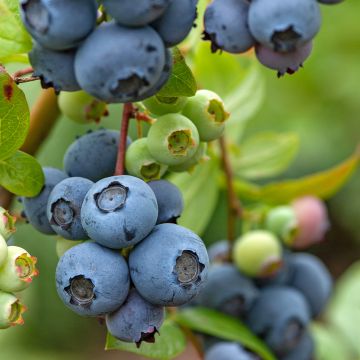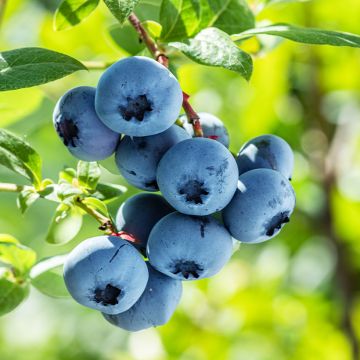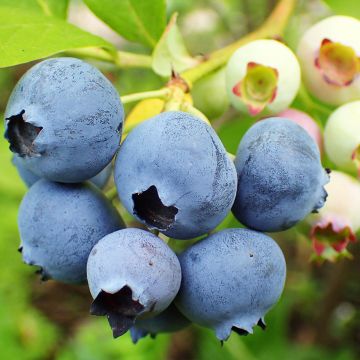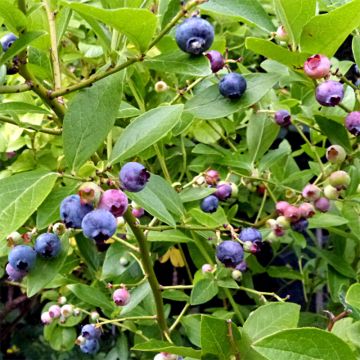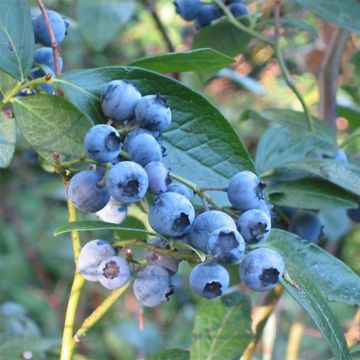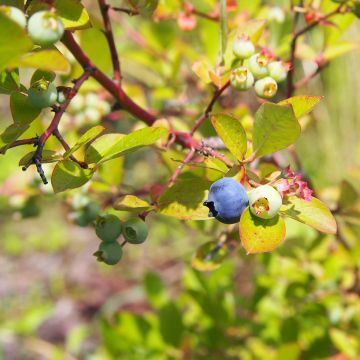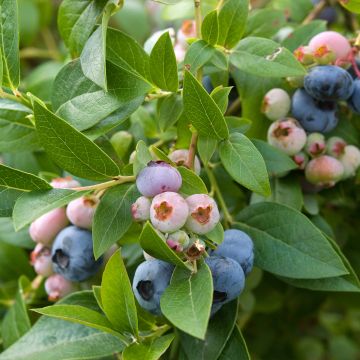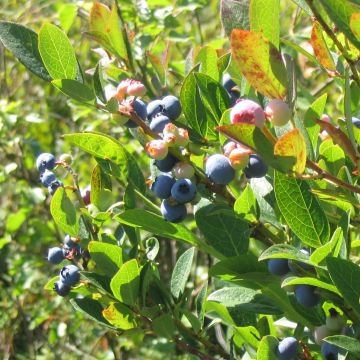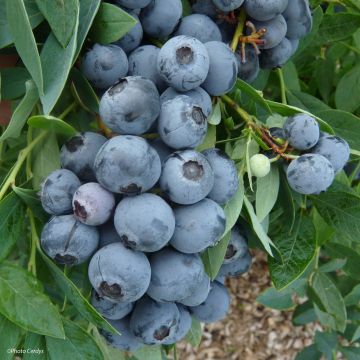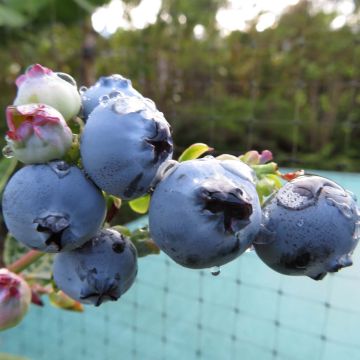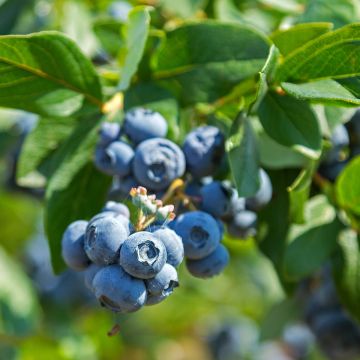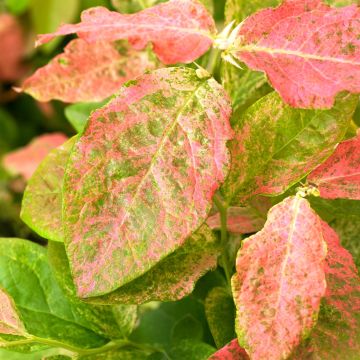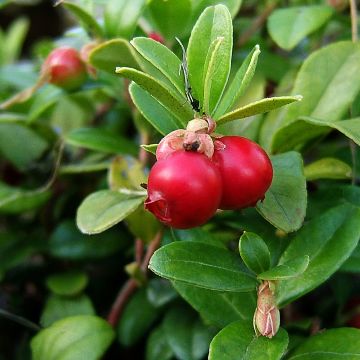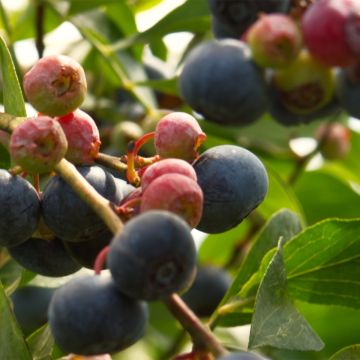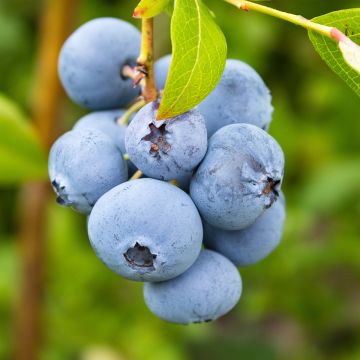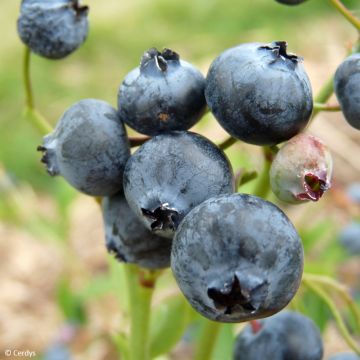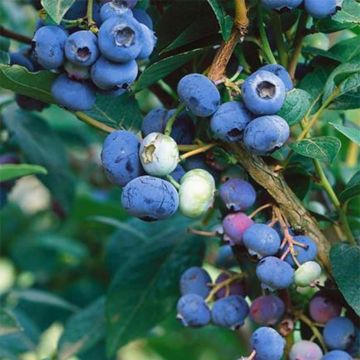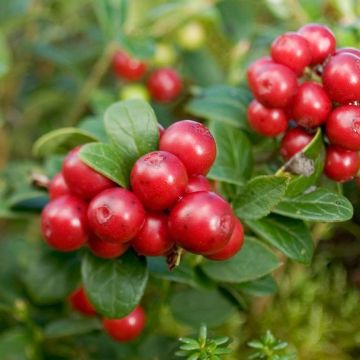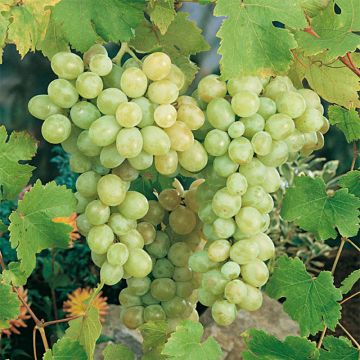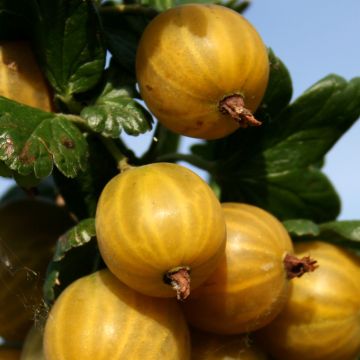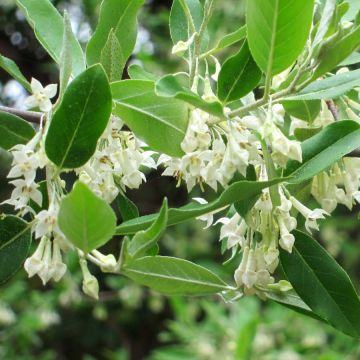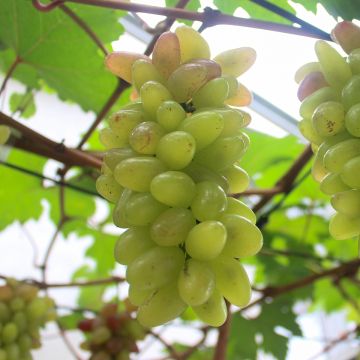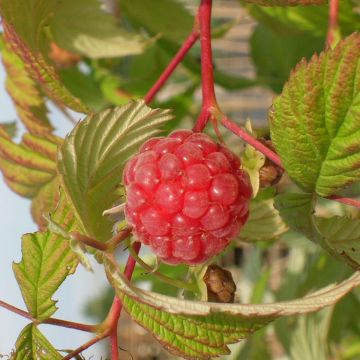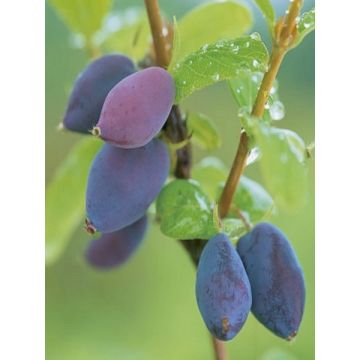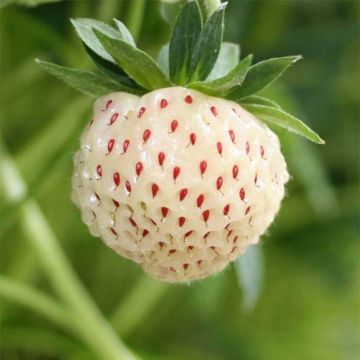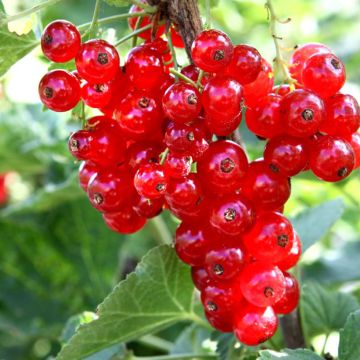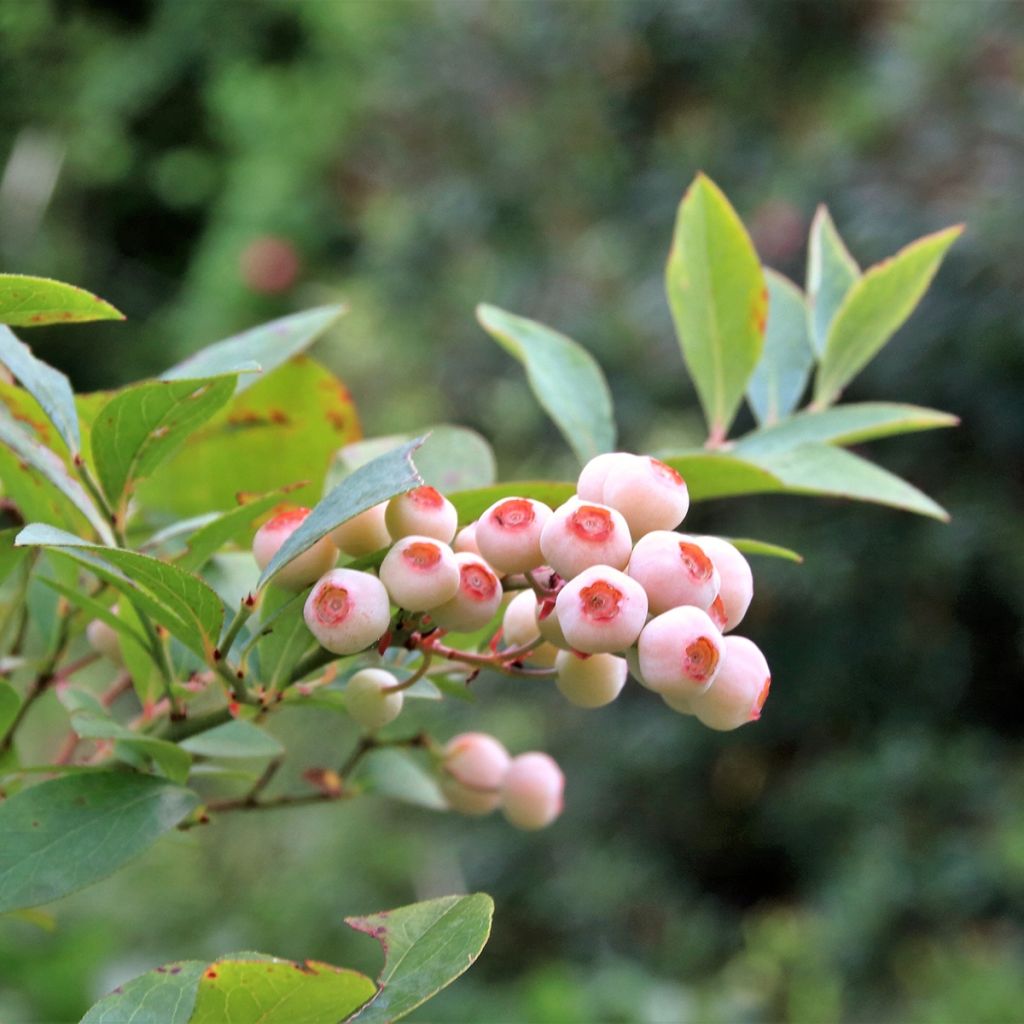

Vaccinium corymbosum Pink Bonbons- American Blueberry
Vaccinium corymbosum Pink Bonbons- American Blueberry
Vaccinium corymbosum Pink Bonbons
American Blueberry, Highbush Blueberry
Why not try an alternative variety in stock?
View all →This plant carries a 6 months recovery warranty
More information
We guarantee the quality of our plants for a full growing cycle, and will replace at our expense any plant that fails to recover under normal climatic and planting conditions.
From €5.90 for pickup delivery and €6.90 for home delivery
Express home delivery from €8.90.
Delivery to Corse prohibited: UE law prohibits the import of this plant from mainland France to Corse as part of the fight against Xylella fastidiosa. Please accept our sincere apologies.
More information
Description
Vaccinium corymbosum 'Pink Bonbons' brings a touch of charm to the blueberry kingdom and to the orchard. This vigorous variety produces pink and cream berries that turn deep pink when fully ripe and have a sweet and sugary flavour similar to blackberries. They are borne by a compact bush that takes on magnificent purple colours in autumn. This variety is well suited for small spaces and container gardening and resistant to cold, it is easy to grow in non-chalky soil and requires little maintenance. In all blueberries, fruiting is more abundant if another variety is planted nearby.
Blueberry belongs to the Ericaceae family, like heather and rhododendrons. The highbush blueberry (Vaccinium corymbosum), native to North America, is the one cultivated in gardens for its abundant and high-quality fruit. It is an extremely cold-resistant shrub, with deciduous foliage that falls in autumn. It is easy to grow in very acidic, non-chalky soil, in a partially shaded location, such as in the morning sun.
The 'Pink Bonbons' cultivar is an American horticultural creation. It forms a dense, spreading bush, reaching an average size of 1 m (3ft) in all directions. The leaves are 2 to 3 cm (1in) long, lanceolate, elliptical, entire, and toothed. They are dark green until summer, then turn yellow, orange, red, and purple in autumn. Flowering occurs in May, in the form of small white bell-shaped flowers with pink edges, measuring 0.5 to 1 cm (0in) long, arranged in pendant clusters 2 to 5 cm (1 to 2in) long at the tips of the stems. This is followed by numerous berries blending light pink and creamy yellow covered in bloom, slightly flattened and 1 cm (0in) in diameter, which ripen in July-August. Harvesting will be staggered according to the ripening of the fruit. Blueberries are firm and sweet, with a slightly acidic flavour. The yield is high, around 4 to 5 kg per plant under good conditions. Blueberries are low in calories but highly nutritious: they are rich in vitamins A, B, and C, calcium, and iron. They contain pigments (anthocyanins) that improve night vision. Blueberries can be eaten fresh, in juice, jam, jelly, sorbet, or in pastries (pies, muffins...). The fruit can be stored for about ten days after picking and can be frozen for longer preservation.
The Pink Bonbons blueberry is self-fertile, but it will bear more fruit in the presence of another blueberry plant, either of the same variety or a different one. Plant Coville or Lateblue blueberry plants near it to ensure a good harvest. In ornamental gardens, the 'Pink Bonbons' blueberry is a truly charming shrub, which will blend in perfectly with acid soil beds, alongside rhododendrons, azaleas, hydrangeas, andromedas, heathers, Mayberry... It also grows very well in a large container: monitor watering (with non-alkaline water) and regularly feed your blueberry plant.
Report an error about the product description
Vaccinium corymbosum Pink Bonbons- American Blueberry in pictures


Plant habit
Fruit
Flowering
Foliage
Botanical data
Vaccinium
corymbosum
Pink Bonbons
Ericaceae
American Blueberry, Highbush Blueberry
Cultivar or hybrid
Other Blueberry bush
Planting and care
The Blueberry Bush is best planted in autumn but can be done throughout the year, avoiding frost and heatwaves. This bush should be planted in a sunny (not scorching) location in the north, and strictly in partial shade in the south. Its beautifully variegated foliage is sensitive to the burn of too much sunlight. Choose a sheltered spot. If you plant multiple bushes, space them 1.20 meters (4 feet) apart in all directions. The Blueberry Bush is very hardy (tolerating temperatures as low as -30°C (-22°F) for the plant, but only -5°C (23°F) for the flowers) and has a particularly long lifespan.
Plant it in acidic soil (pH between 4 and 5.5), incorporating ericaceous soil or a mixture of ordinary soil and well-decomposed bark compost. The collar (the point where the trunk meets the roots) should be level with the ground. Firmly press the soil and water generously, with non-limestone water. In slightly chalky soil, dig a hole 50 to 60 cm (20 to 24in) deep, line the edges with a garden felt, place a 10 cm (4in) layer of non-limestone gravel at the bottom, then fill with a mixture of compost and ericaceous soil.
The soil should remain moist but not waterlogged: the plant tolerates moderate drought and dislikes stagnant moisture. If watering is necessary, use non-limestone and non-chlorinated water (such as rainwater, for example). Mulch the base with shredded bark, straw, or fern leaves. It is sometimes useful to place a protective net if birds become too greedy during harvest. Annually in spring, add a little well-rotted compost on the surface. The Blueberry Bush is not very susceptible to diseases and pests.
Planting period
Intended location
Care
This item has not been reviewed yet - be the first to leave a review about it.
Berries
Haven't found what you were looking for?
Hardiness is the lowest winter temperature a plant can endure without suffering serious damage or even dying. However, hardiness is affected by location (a sheltered area, such as a patio), protection (winter cover) and soil type (hardiness is improved by well-drained soil).

Photo Sharing Terms & Conditions
In order to encourage gardeners to interact and share their experiences, Promesse de fleurs offers various media enabling content to be uploaded onto its Site - in particular via the ‘Photo sharing’ module.
The User agrees to refrain from:
- Posting any content that is illegal, prejudicial, insulting, racist, inciteful to hatred, revisionist, contrary to public decency, that infringes on privacy or on the privacy rights of third parties, in particular the publicity rights of persons and goods, intellectual property rights, or the right to privacy.
- Submitting content on behalf of a third party;
- Impersonate the identity of a third party and/or publish any personal information about a third party;
In general, the User undertakes to refrain from any unethical behaviour.
All Content (in particular text, comments, files, images, photos, videos, creative works, etc.), which may be subject to property or intellectual property rights, image or other private rights, shall remain the property of the User, subject to the limited rights granted by the terms of the licence granted by Promesse de fleurs as stated below. Users are at liberty to publish or not to publish such Content on the Site, notably via the ‘Photo Sharing’ facility, and accept that this Content shall be made public and freely accessible, notably on the Internet.
Users further acknowledge, undertake to have ,and guarantee that they hold all necessary rights and permissions to publish such material on the Site, in particular with regard to the legislation in force pertaining to any privacy, property, intellectual property, image, or contractual rights, or rights of any other nature. By publishing such Content on the Site, Users acknowledge accepting full liability as publishers of the Content within the meaning of the law, and grant Promesse de fleurs, free of charge, an inclusive, worldwide licence for the said Content for the entire duration of its publication, including all reproduction, representation, up/downloading, displaying, performing, transmission, and storage rights.
Users also grant permission for their name to be linked to the Content and accept that this link may not always be made available.
By engaging in posting material, Users consent to their Content becoming automatically accessible on the Internet, in particular on other sites and/or blogs and/or web pages of the Promesse de fleurs site, including in particular social pages and the Promesse de fleurs catalogue.
Users may secure the removal of entrusted content free of charge by issuing a simple request via our contact form.
The flowering period indicated on our website applies to countries and regions located in USDA zone 8 (France, the United Kingdom, Ireland, the Netherlands, etc.)
It will vary according to where you live:
- In zones 9 to 10 (Italy, Spain, Greece, etc.), flowering will occur about 2 to 4 weeks earlier.
- In zones 6 to 7 (Germany, Poland, Slovenia, and lower mountainous regions), flowering will be delayed by 2 to 3 weeks.
- In zone 5 (Central Europe, Scandinavia), blooming will be delayed by 3 to 5 weeks.
In temperate climates, pruning of spring-flowering shrubs (forsythia, spireas, etc.) should be done just after flowering.
Pruning of summer-flowering shrubs (Indian Lilac, Perovskia, etc.) can be done in winter or spring.
In cold regions as well as with frost-sensitive plants, avoid pruning too early when severe frosts may still occur.
The planting period indicated on our website applies to countries and regions located in USDA zone 8 (France, United Kingdom, Ireland, Netherlands).
It will vary according to where you live:
- In Mediterranean zones (Marseille, Madrid, Milan, etc.), autumn and winter are the best planting periods.
- In continental zones (Strasbourg, Munich, Vienna, etc.), delay planting by 2 to 3 weeks in spring and bring it forward by 2 to 4 weeks in autumn.
- In mountainous regions (the Alps, Pyrenees, Carpathians, etc.), it is best to plant in late spring (May-June) or late summer (August-September).
The harvesting period indicated on our website applies to countries and regions in USDA zone 8 (France, England, Ireland, the Netherlands).
In colder areas (Scandinavia, Poland, Austria...) fruit and vegetable harvests are likely to be delayed by 3-4 weeks.
In warmer areas (Italy, Spain, Greece, etc.), harvesting will probably take place earlier, depending on weather conditions.
The sowing periods indicated on our website apply to countries and regions within USDA Zone 8 (France, UK, Ireland, Netherlands).
In colder areas (Scandinavia, Poland, Austria...), delay any outdoor sowing by 3-4 weeks, or sow under glass.
In warmer climes (Italy, Spain, Greece, etc.), bring outdoor sowing forward by a few weeks.

































